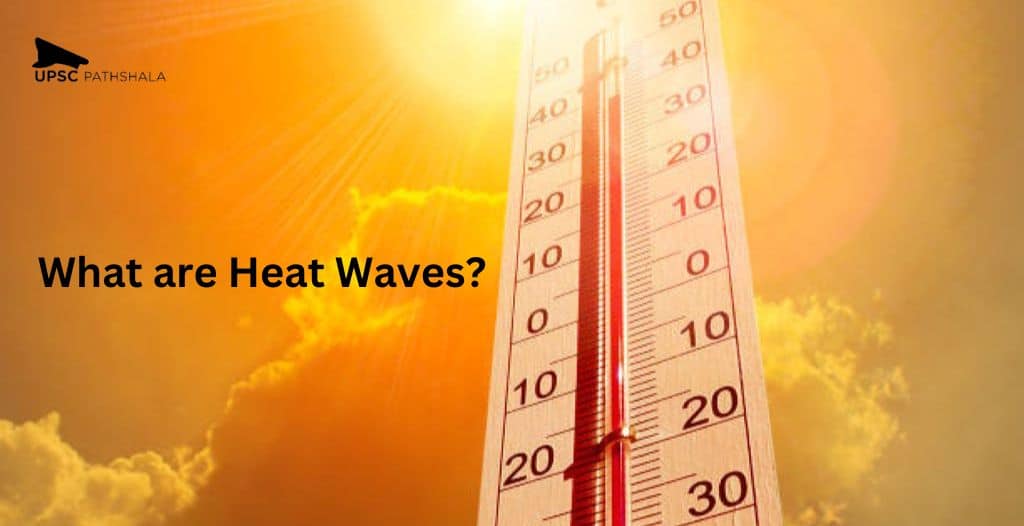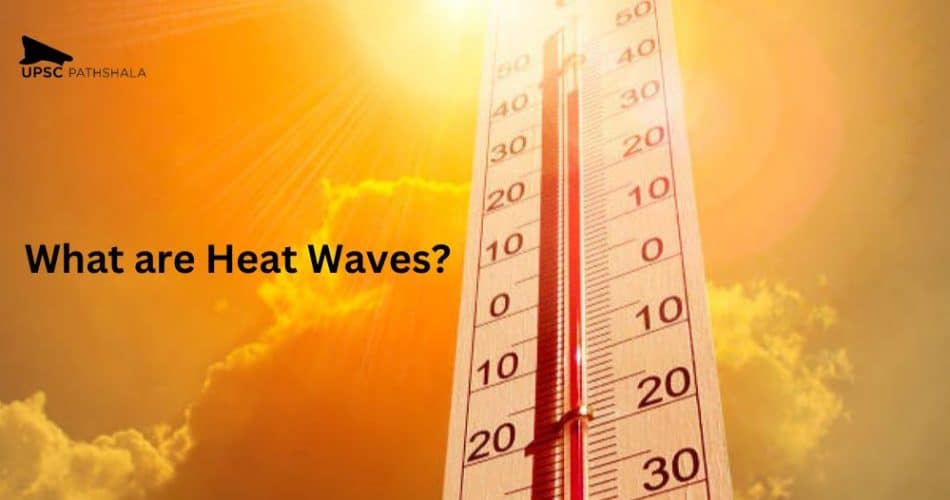Theme: Important Geophysical Phenomena
Source: The Hindu
Why in news: The India Meteorological Department (IMD) warned that the maximum temperatures over northwest, west, and central India would be 3-5° C higher than the long-term average.
On February 21 itself, the national capital recorded its third hottest February day (33.6° C) in more than five decades.

What are Heat waves?
- Period of abnormally high temperatures, more than the normal maximum temperature that occurs during the summer season
- Typically occurs between March and June, and in some rare cases even extends till July.
What are the criteria for Heat Waves?
- According to the Indian Meteorological Department (IMD), Heat Wave need not be considered till maximum temperature of a station reaches atleast 40°C for Plains and atleast 30°C for Hilly regions
Normal Minimum Temperature:
- Less than or equal to 40°C: An increase of 5°C to 6°C from the normal temperature is considered to be heat wave condition. Further, an increase of 7°C or more from the normal temperature is considered a severe heat wave condition.
- More than 40°C: An increase of 4°C to 5°C from the normal temperature is considered to be heat wave condition. Further, an increase of 6°C or more is considered a severe heat wave condition.
- Heat Wave in coastal region: When maximum temperature departure is 4.50°C or more from normal, Heat Wave may be described provided actual maximum temperature is 37°C or more
- Actual Minimum Temperature: When actual maximum temperature remains 45°C or more irrespective of normal maximum temperature, heat waves should be declared.
How do heat waves occur?
- Direction of Airflow:
- In spring, India typically has air flowing in from the west-northwest.
- In the context of climate change, the Middle East is warming faster than other regions in latitudes, and serves as a source of the warm air that blows into India.
- Compression of air
- Air flowing in from the northwest rolls in over the mountains of Afghanistan and Pakistan.
- As a result, some of the compression also happens on the leeward side of these mountains, entering India with a bristling warmth.
- Warmer Arabian Sea
- The air flowing in over the oceans is expected to bring cooler air, since land warms faster than the oceans.
- However, this does not happen as the Arabian Sea is warming faster than most other ocean regions.
- Role of upper atmospheric westerly winds
- The strong upper atmospheric westerly winds that come in from the Atlantic Ocean over to India during spring control the near-surface winds.
- Any time winds flow from the west to the east, the winds are blowing faster than the planet itself, which is also rotating from west to east.
- The energy to run past the earth near the surface, against the surface friction, can only come from above.
- This descending air compresses and warms up to generate some heat waves.
- Declining lapse rate
- Lapse Rate is the rate at which temperature cools from the surface to the Upper atmosphere
- It should be noted that the lapse rate is declining under global warming.
- In other words, global warming tends to warm the upper atmosphere faster than the air near the surface.
- Hence, the sinking air is warmer due to global warming, and thus produces heat waves as it sinks and compresses.
How does air mass contribute to heat waves?
- The other factors that affect the formation of heat waves are the age of the air mass and how far it has travelled.
- The north-northwestern heatwaves are typically formed with air masses that come from 800-1,600 km away and are around two days old.
- Heat waves over peninsular India on the other hand arrive from the oceans and are barely a day old. As a result, they are on average less intense.
Why did heat waves start to occur more frequently?
- Due to the processes that contribute to the formation of a heat wave, and the ways in which global warming affects them, these events have started to occur once every few years, and are also more intense.
- The area covered by these heat waves is also influenced by the background pressure patterns set up by El Niño and La Niña events, and of late it has been expanding.
Indian Subcontinent:
- Heat waves are expected to become longer and more intense and frequent over the Indian subcontinent.
- In 2022 itself, the heat waves started early and were more numerous.
- They also extended further south into peninsular India due to a north south pressure pattern set up by the La Niña
- La Nina is a world-affecting weather phenomenon in which a band of cool water spreads eastwest across the equatorial Pacific Ocean.
What are the strategies adopted to mitigate the impact of heat waves?
- Heat Waves Action Plan:
- Aims to provide a framework for implementation, coordination and evaluation of extreme heat response activities in cities/town in India that reduces the negative impact of extreme heat
- Recognition of Heat Waves as a Natural Disaster:
- The National Disaster Management Act, 2005, and the National Policy on Disaster Management, 2009, do not consider heatwaves to be a natural disaster.
- It is not notified in the list of 12 disasters eligible for relief through national or state disaster relief funds.
- Recognition as a natural disaster would help the state and district administration prepare a heatwave action plan at the regional level.
- Passive cooling technology:
- Adoption of Passive cooling technology to create naturally ventilated buildings, can be an important alternative to address the urban heat island for residential and commercial buildings.
- Establish Early Warning System and Inter-Agency Coordination:
- To alert residents on predicted high and extreme temperatures.
- Public Awareness and community outreach:
- Disseminating public awareness messages on how to protect against the extreme heatwave through print, electronic and social media and Information, Education and Communication materials.
Way Forward:
- Although, the mortality over India due to heat waves are substantially lower than those in other mid-latitude regions.
- It’s important to further improve forecast warnings and these forecasts should be coupled with city-wide graded heat action plans to protect the vulnerable.
Static Part to be referred: Heat Waves; Trade Winds; IMD; NDMA Act;
Practice Mains Question:
| What are Heat Waves? Why do heat waves occur and discuss the reasons for more frequent and intense heat waves recently? (250 words, 15 marks) |
Summary

Article Name
Daily Current Affairs | Heat wave | 27th Feb
Description
Get the daily current affairs updates for UPSC preparation. Stay updated with the latest news, insights, analysis & study material on current affairs, Heat wave and other relevant topics for UPSC exams.
Author
ufaber
Publisher Name
UPSC Pathshala
Publisher Logo

Show Comments





